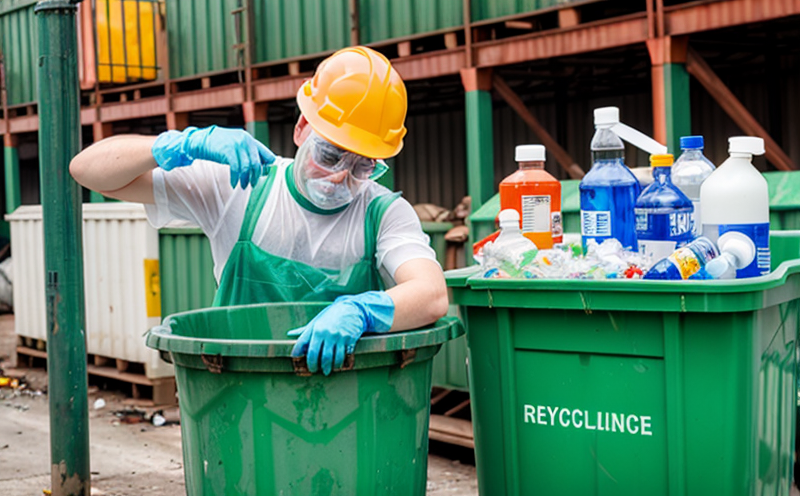EPA 8270 Semi Volatile Organic Compound Testing in Waste
The EPA 8270 method is a critical tool used by laboratories to identify and quantify semi-volatile organic compounds (SVOCs) in waste materials. SVOCs are a class of contaminants that have boiling points above room temperature but below 350°F, making them challenging to detect using traditional analytical techniques.
This testing is essential for ensuring compliance with environmental regulations aimed at protecting human health and the environment from hazardous substances. The EPA 8270 method employs thermal desorption/gas chromatography/mass spectrometry (TD/GC/MS) to extract SVOCs from solid waste samples, followed by their identification and quantification.
The testing process begins with sample preparation, which involves the extraction of organic compounds using solvents like dichloromethane or hexane. The extracted compounds are then concentrated and desorbed for analysis via gas chromatography. This method ensures that even trace amounts of SVOCs can be detected, providing precise data for regulatory compliance.
The EPA 8270 method is particularly useful in the waste and recycling sector as it helps companies meet stringent environmental standards set by regulatory bodies like the U.S. Environmental Protection Agency (EPA). By identifying hazardous materials within waste streams, this testing can prevent the release of harmful SVOCs into the environment.
Compliance with regulations such as RCRA (Resource Conservation and Recovery Act) is crucial for waste management facilities, recycling plants, and manufacturers dealing with hazardous substances. EPA 8270 ensures that these entities operate within legal boundaries while also promoting sustainability practices.
The testing process involves rigorous quality control measures to ensure accuracy and reliability of results. This includes the use of certified reference materials (CRMs) for calibration purposes and regular method validation checks. The laboratory adheres strictly to ISO 17025 accreditation standards, ensuring that all tests meet international quality assurance criteria.
For R&D engineers and procurement professionals, EPA 8270 testing provides valuable insights into the composition of waste streams. This information can be used to develop more efficient recycling processes or design safer products from recycled materials. In addition, it aids in sourcing raw materials that are free from hazardous SVOCs.
Environmental and sustainability contributions through EPA 8270 testing extend beyond regulatory compliance. By identifying pollutants early in the waste management process, this method helps reduce the environmental impact associated with improper disposal of hazardous substances. It also supports the development of circular economy practices by enabling safer recycling processes.
Environmental and Sustainability Contributions
- Reduction of Hazardous Waste: By identifying SVOCs early in waste streams, EPA 8270 testing helps divert hazardous materials from landfills, thus reducing their environmental impact.
- Promotion of Sustainable Recycling: The data obtained through this testing can guide the creation of more efficient recycling processes that minimize contamination and maximize resource recovery.
The use of EPA 8270 semi-volatile organic compound testing contributes significantly to sustainability goals by promoting cleaner production methods and encouraging responsible waste management practices. This aligns with broader initiatives aimed at reducing greenhouse gas emissions and minimizing ecological footprints.
By ensuring proper disposal and recycling of hazardous materials, this method supports the transition towards a more sustainable and circular economy. It also enhances public trust in companies committed to environmental stewardship by providing transparent reporting on waste management practices.
Competitive Advantage and Market Impact
EPA 8270 semi-volatile organic compound testing offers several competitive advantages for businesses operating within the waste and recycling sector. Compliance with this testing ensures that companies meet regulatory requirements, thereby avoiding costly fines or legal actions.
By offering reliable and accurate test results, laboratories can build strong relationships with clients who rely on these services to ensure environmental compliance. This trust fosters long-term partnerships, enhancing brand reputation and market standing.
The ability to provide detailed analytical data helps companies make informed decisions regarding waste treatment and recycling processes. This knowledge allows them to innovate and develop new products or services that align with growing consumer demand for eco-friendly solutions.
Moreover, adherence to EPA 8270 testing can differentiate a business from competitors who may not prioritize environmental sustainability. In today’s market, where consumers increasingly seek out green credentials, demonstrating commitment to environmental stewardship through rigorous testing protocols can significantly enhance competitiveness and attract environmentally-conscious customers.
The implementation of EPA 8270 semi-volatile organic compound testing also supports broader sustainability initiatives within the industry. By driving improvements in waste management practices, this method contributes to more sustainable business operations overall.
Use Cases and Application Examples
- Recycling Facility: A recycling facility that processes mixed municipal solid waste uses EPA 8270 testing to identify hazardous SVOCs before they enter the recycling stream. This prevents contamination of recyclable materials and ensures only safe, reusable products are processed.
- Hazardous Waste Disposal: In hazardous waste disposal sites, EPA 8270 testing is used to ensure that waste containing harmful SVOCs is properly managed according to regulatory guidelines. This helps prevent unauthorized releases into the environment.
EPA 8270 semi-volatile organic compound testing plays a vital role in various industries, including manufacturing, pharmaceuticals, and electronics. These sectors often generate waste streams rich in SVOCs due to their chemical processes. By applying this method, companies can ensure proper handling of these materials throughout the supply chain.
The use cases for EPA 8270 testing are not limited to industrial settings; it also applies in academic research and governmental agencies focused on environmental protection. In these contexts, the results obtained through this method contribute valuable information towards understanding pollutant behaviors and developing effective mitigation strategies.





